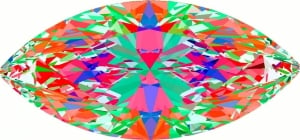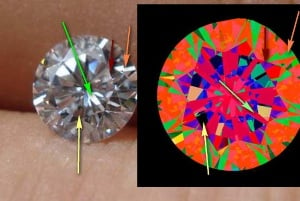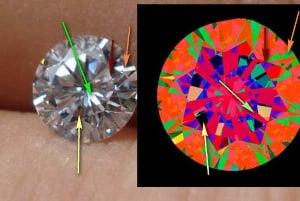- Joined
- Jan 7, 2009
- Messages
- 10,394
I've been using my aset more and more, on many different stones.
I'm looking at it in a different light and opening my mind to the possibilities.
BTW- I don't find it easy at all to use if I'm holding the diamond in tweezers- it's much easier to get a photo on the light and look at that.
In that regard, I'll admit it's great for internet representation. On that point, when looking at stones with a more organized facet pattern ( ie not crushed ice) and aset images are well explained by a vendor who's in physical possession of the diamond to correlate the aset with reality, I can see the utility.
This is a far cry from an individual asking for an aset image from Whateverjeweler.com, posting it on PS to have it evaluated.
As far as how to interpret aset from crushed ice, the jury is out.
ccl brings up a good point. He's doing what I am referring to- that being, evaluating aset with no "reality check"
Green can be very good- that much I can see easily looking at a variety of "sparkly" crushed ice stones.
ccl mentioned crown light usage.
Given that the main lighting source is beneath the diamond, isn't the light below the diamond far brighter than the reflection of that light from the aset unit?
Seems to me you're shooting a lot of light up through the pavilion
I'm looking at it in a different light and opening my mind to the possibilities.
BTW- I don't find it easy at all to use if I'm holding the diamond in tweezers- it's much easier to get a photo on the light and look at that.
In that regard, I'll admit it's great for internet representation. On that point, when looking at stones with a more organized facet pattern ( ie not crushed ice) and aset images are well explained by a vendor who's in physical possession of the diamond to correlate the aset with reality, I can see the utility.
This is a far cry from an individual asking for an aset image from Whateverjeweler.com, posting it on PS to have it evaluated.
As far as how to interpret aset from crushed ice, the jury is out.
ChunkyCushionLover said:Let us not forget your biggest mistake of all in that photograph.
The ASET evaluates through the crown lighting.
Pretty hard to reproduce a through the crown evaluation when you hold up a stone in tweezers and light the pavilion.
Take a photograph with the stone in the tray (pavilion blocked) like you did before, you'll find the bowtie areas much easier to find.
You also asked how do you evaluate marquises, well first you realize all the leakage(white) and weak light return(green) areas in the example you posted.
Then you find a a marquise that has an ASET that looks more like this. (Hint: its not a brand name, not fully optimized, just a set of well aligned proportions and happens to be the default cut parameters for marquise in Diamcalc.)

ccl brings up a good point. He's doing what I am referring to- that being, evaluating aset with no "reality check"
Green can be very good- that much I can see easily looking at a variety of "sparkly" crushed ice stones.
ccl mentioned crown light usage.
Given that the main lighting source is beneath the diamond, isn't the light below the diamond far brighter than the reflection of that light from the aset unit?
Seems to me you're shooting a lot of light up through the pavilion





300x240.png)